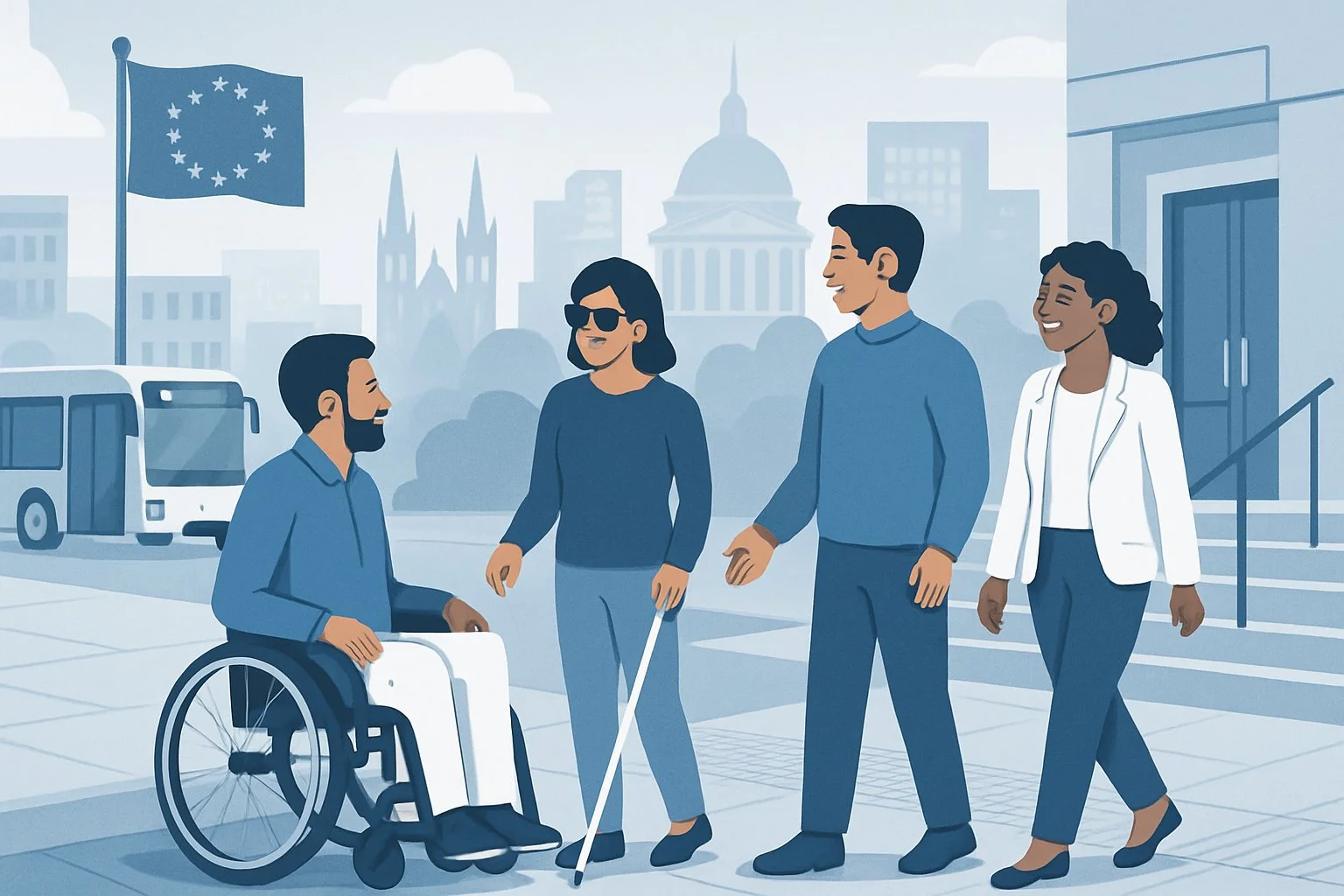
Who Does the European Accessibility Act Apply To?
Who Does the European Accessibility Act Apply To? A Guide for Mobile Apps
The European Accessibility Act has created confusion for many businesses about whether they need to comply with its requirements. The EAA applies to economic operators providing certain products and services listed in the directive, including non-EU companies that place covered products or services on the EU market.
With the enforcement deadline set for June 2025, businesses across various sectors are working to understand their obligations. The Act targets specific products and services that are crucial for people with disabilities, including smartphones, banking services, e-commerce platforms, and mobile applications. Mid-market enterprises face challenges in implementing these requirements, and international companies must ensure compliance even when operating from outside the EU.
Understanding who the Act affects helps organisations determine their next steps. The International Association of Accessibility Professionals (IAAP) offers guidance on these requirements, helping organisations understand their responsibilities under this legislation.
Understanding The European Accessibility Act

The European Accessibility Act (EAA) is an EU directive that became law in April 2019. It aims to harmonise accessibility requirements across all EU member states by June 28, 2025.
The EAA is supported by EN 301 549, which references WCAG 2.1 AA as part of its technical accessibility requirements.
Key objectives include:
- Creating unified accessibility rules across the EU
- Improving access for people with disabilities
- Supporting the UN Convention on the Rights of Persons with Disabilities (CRPD)
- Making everyday products and services more inclusive
The directive applies to key digital services and a limited set of physical products, such as self-service terminals and consumer hardware used to access essential services.
WCAG 2.1 forms the current technical foundation under EN 301 549. WCAG 2.2 introduces useful enhancements but is not yet required under the harmonised EU standard. These guidelines follow the POUR principles: Perceivable, Operable, Understandable, and Robust.
The EAA requires functional accessibility aligned with EN 301 549, which includes WCAG 2.1 AA and additional requirements for software and documentation. Public sector bodies already follow similar rules under existing Public Sector Bodies Accessibility Regulations.
Each EU member state can set its own penalties for non-compliance. The directive allows countries to create stricter rules if needed.
WCAG standards provide the technical roadmap for compliance. Businesses should familiarise themselves with these accessibility principles early to avoid last-minute changes.
Scope Of The Act

The European Accessibility Act covers specific products and services that are essential for people with disabilities across the EU market. Mobile apps face particular requirements, and various types of organisations must comply based on their role in bringing products and services to consumers.
Applicability To Mobile Apps
Mobile apps must meet the EAA's digital accessibility requirements when they're part of covered services. Banking apps, e-commerce platforms, and transport booking applications need to meet accessibility standards.
These apps must work with assistive technologies like screen readers. They should include accessibility features such as proper text descriptions and keyboard navigation support.
Service providers ensure their mobile interfaces comply with accessibility guidelines, including both the app and related digital services.
Apps connected to consumer banking services face strict requirements. The same applies to mobile platforms for audiovisual media services and passenger transport services.
Manufacturers of mobile operating systems build in accessibility features, making it easier for third-party developers to create accessible apps.
Types Of Organisations Covered
Several categories of organisations must comply with the EAA. Manufacturers who produce accessible products have primary responsibility for meeting accessibility requirements.
Service providers offering covered services in the EU must ensure digital accessibility. This includes banks providing consumer banking services and companies running e-commerce platforms.
Importers bringing products from outside the EU must verify accessibility standards are met. Distributors selling these products within the EU market also have compliance duties.
Economic operators at each supply chain level share responsibility. Authorised representatives acting for manufacturers must understand accessibility guidelines.
Microenterprises with fewer than 10 employees and annual turnover under €2 million are exempt. Larger organisations providing financial services, transport services, or audiovisual media services must comply regardless of their size.
Public and private sector organisations must meet EAA accessibility requirements when acting as economic operators of in-scope services or products.
Obligations For Mid Market Enterprises
Mid market enterprises must fully comply with the European Accessibility Act. Unlike microenterprises, these businesses cannot claim exemptions based on size or revenue.
Core Compliance Requirements:
Mid market companies need to complete several steps before the 28th June 2025 deadline:
- Conformity assessment procedures to verify accessibility compliance
- Preparation of technical documentation demonstrating how products meet EAA requirements
- Completion of an EU declaration of conformity for applicable products
- Application of CE marking where required for physical products
Market Surveillance Considerations:
Market surveillance authorities will monitor compliance across EU member states. These authorities can request documentation and inspect mid market enterprises.
Maintain comprehensive records of all accessibility measures. This documentation proves compliance during potential market surveillance reviews.
Representation Requirements:
Non-EU companies supplying covered physical products may be required to appoint an authorised representative. This requirement generally applies to non-EU manufacturers of physical products. For digital-only services, representation requirements are rare and depend on specific risk and enforcement frameworks.
Service Obligations:
For digital services, mid market companies must ensure platforms meet WCAG 2.1 AA standards. This includes e-commerce sites, banking services, and transport booking platforms.
Documentation Management:
Keep technical documentation accessible for ten years after product placement on the market. This includes accessibility test results and conformity assessment reports.
Mid market enterprises should begin compliance preparation immediately. The obligations are extensive and require thorough planning to meet the upcoming deadline.
Compliance Challenges For Mobile App Providers
Mobile app providers face unique hurdles when working towards EAA compliance. The technical requirements go beyond basic website accessibility standards.
Mobile applications must meet EN 301 549 standards, which include WCAG 2.1 guidelines at AA level. This creates challenges for touch interfaces, gesture controls, and mobile-specific features.
Key compliance challenges include:
- Screen reader compatibility across iOS and Android platforms
- Voice control and assistive technology integration
- Keyboard navigation for external keyboards
- Text scaling and contrast adjustments
- Alternative input methods for users with motor impairments
App store distribution adds complexity. Accessibility features must work consistently across different mobile operating systems and device manufacturers.
Mobile apps must include an accessibility statement, either within the app or by linking to an accessible web-based version, explaining how the app meets accessibility requirements. Developers must document how the app meets accessibility requirements and provide clear instructions for users with disabilities.
Testing becomes more complex with mobile apps due to the variety of assistive technologies available. Developers must test across multiple devices, screen sizes, and accessibility tools.
Accessibility compliance requires ongoing monitoring as mobile operating systems update frequently. Each iOS or Android update can affect an app's accessibility features.
Penalties for non-compliance are set at the national level and vary by country. Some may include substantial fines or enforcement actions.
How AUDITSU Supports Accessibility Assessments
AUDITSU provides comprehensive accessibility audits to help organisations meet European Accessibility Act requirements. Their platform offers automated compliance checking and risk intelligence for businesses preparing for EAA deadlines.
The company specialises in mobile app accessibility assessments aligned with EAA standards. Their audit system generates clear action plans within minutes, making compliance easier for busy teams.
Key AUDITSU features include:
- Complete accessibility audit coverage
- Automated compliance checking
- Clear remediation guidance
- Risk intelligence reporting
- Mobile app specialisation
AUDITSU targets mid-sized to enterprise organisations navigating EAA compliance. Their data-driven approach helps businesses quickly find accessibility gaps.
The platform reduces legal and operational risk by encouraging companies to fix accessibility problems early in development. This proactive approach allows businesses to avoid potential prosecution and fines.
AUDITSU's accessibility audits cover essential compliance areas required under the European Accessibility Act. Their system checks digital products against established accessibility standards and guidelines.
The automated system streamlines the audit process. Organisations get detailed reports showing where they need to improve to meet EAA requirements.